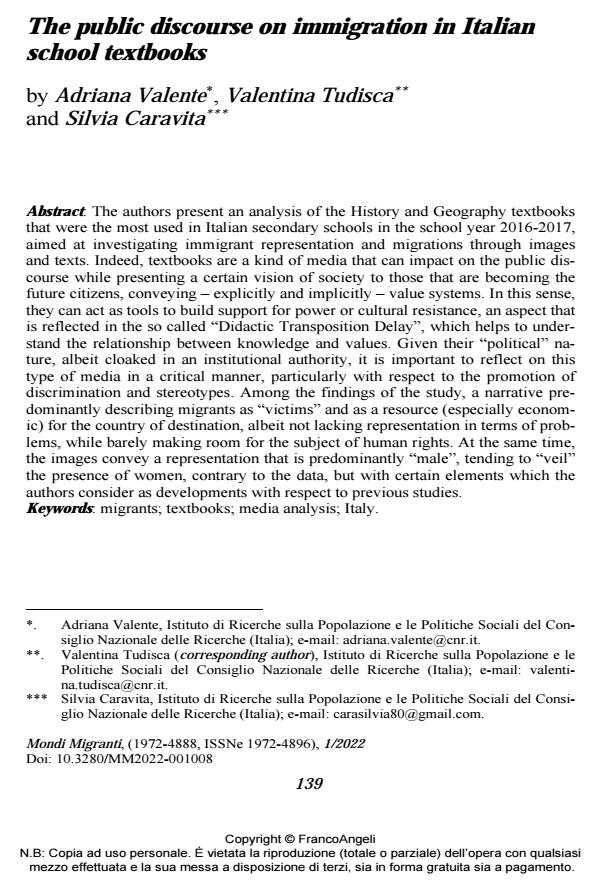The public discourse on immigration in Italian school textbooks
Journal title MONDI MIGRANTI
Author/s Adriana Valente, Valentina Tudisca, Silvia Caravita
Publishing Year 2022 Issue 2022/1
Language English Pages 19 P. 139-157 File size 287 KB
DOI 10.3280/MM2022-001008
DOI is like a bar code for intellectual property: to have more infomation
click here
Below, you can see the article first page
If you want to buy this article in PDF format, you can do it, following the instructions to buy download credits

FrancoAngeli is member of Publishers International Linking Association, Inc (PILA), a not-for-profit association which run the CrossRef service enabling links to and from online scholarly content.
The authors present an analysis of the History and Geography textbooks that were the most used in Italian secondary schools in the school year 2016-2017, aimed at investigating immigrant representation and migrations through images and texts. Indeed, textbooks are a kind of media that can impact on the public discourse while presenting a certain vision of society to those that are becoming the future citizens, conveying - explicitly and implicitly - value systems. In this sense, they can act as tools to build support for power or cultural resistance, an aspect that is reflected in the so called "Didactic Transposition Delay", which helps to understand the relationship between knowledge and values. Given their "political" nature, albeit cloaked in an institutional authority, it is important to reflect on this type of media in a critical manner, particularly with respect to the promotion of discrimination and stereotypes. Among the findings of the study, a narrative predominantly describing migrants as "victims" and as a resource (especially eco-nomic) for the country of destination, albeit not lacking representation in terms of problems, while barely making room for the subject of human rights. At the same time, the images convey a representation that is predominantly "male", tending to "veil" the presence of women, contrary to the data, but with certain elements which the authors consider as developments with respect to previous studies.
Keywords: migrants; textbooks; media analysis; Italy.
- Visioni di Europa e fiducia nella scienza della comunità studentesca italiana Valentina Tudisca, Nicolò Marchesini, Adriana Valente, in WELFARE E ERGONOMIA 2/2024 pp.173
DOI: 10.3280/WE2023-002012 - Silencing Refugees’ Voices in Educational Practices Valentina Tudisca, Adriana Valente, pp.79 (ISBN:978-3-031-73517-2)
Adriana Valente, Valentina Tudisca, Silvia Caravita, The public discourse on immigration in Italian school textbooks in "MONDI MIGRANTI" 1/2022, pp 139-157, DOI: 10.3280/MM2022-001008